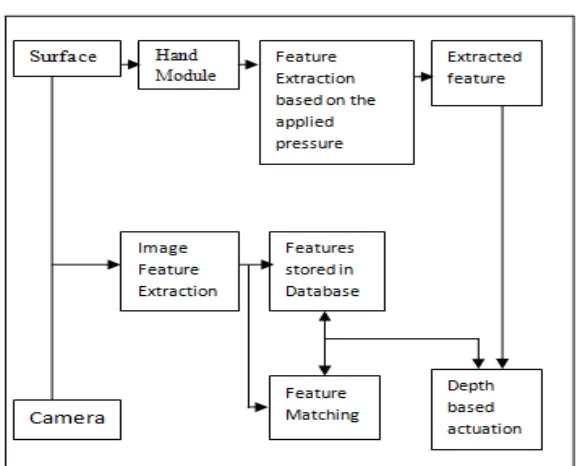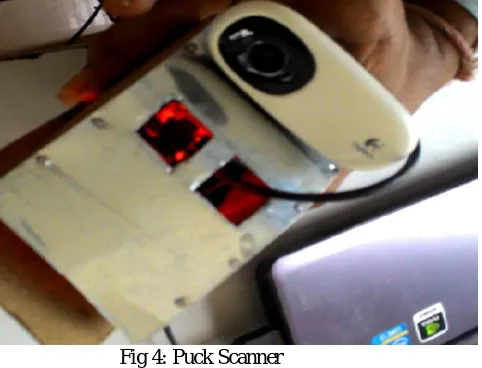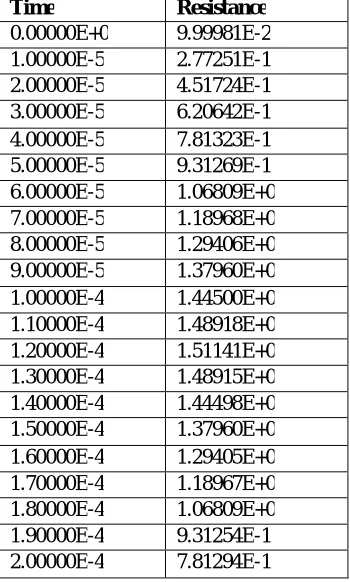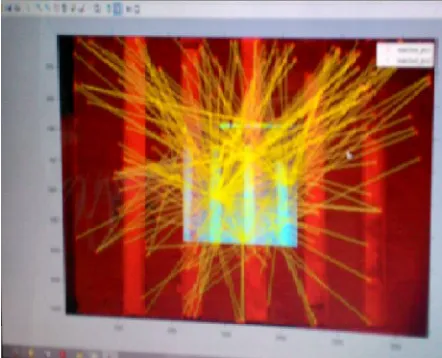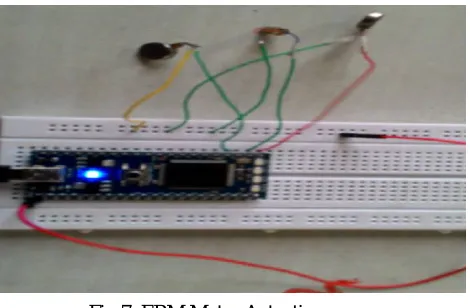ISSN(Online): 2320-9801 ISSN (Print): 2320-9798
I
nternational
J
ournal of
I
nnovative
R
esearch in
C
omputer
and
C
ommunication
E
ngineering
(An ISO 3297: 2007 Certified Organization)
Vol. 4, Issue 4, April 2016
Haptics Human Interaction –Virtual Reality
Kiran Kulkarni1, Manoj Manvi2, Deepti3, Ashwini 4
Researcher, Department of IT, B .V Bhoomaraddi College of Engineering and Technology, Hubli, India1 Students, Department of IT, B .V Bhoomaraddi College of Engineering and Technology, Hubli, India2,3,4
ABSTARCT: Haptics is one of the strategic trending technologies in the world as per the famous GARTNER 2014-15 predictions. This makes it one of the leading technologies to be focused on in the field Engineering and Research studies. It Deals with the simulation of real-world experience using concepts such as augmented reality and virtuality and providing Force feedback to users about the physical properties and movements of virtual objects represented by a computer. Our proposed work aims at perceiving and simulating different surfaces or textures and further providing real-time experience of virtual objects or surfaces allowing the blind users to visualize and sense their surroundings much like bats or dolphins. The proposed work involves two main phases namely feature extraction and feature matching, involving design and development of two devices, a hand module and a puck scanner. In feature extraction process, features (intensity variations) are extracted from the surface constrictions and are recorded using sensors mounted on the hand module. Different pressures are applied and wide ranging responses are obtained which are stored in the Database. For Feature Matching, another module is designed which captures the image on the screen and further, the scanned image is processed and these features are matched with that of the database. Once the features are matched, the module is programmed such that typical frequencies are generated for different pixel values of the matched image and thus giving different vibrations through actuators creating virtual effect of the captured surface. This project would act as a virtual eye for the blind users.
KEYWORDS: FSR, Augmented reality, Haptics, Feature extraction, Virtual reality. I.INTRODUCTION
Haptics technology mainly deals with computer interface devices. It promises to bring profound changes to the way humans interact with information and Communicative ideas. Recent development in computer interface technology now permit us to touch and manipulate imaginary computer generated objects in a way that evokes a compelling sense of tactile realness. Haptics interactions might be as simple as touching a virtual wall or button, or as complex as performing a critical procedure in a surgical simulator. Haptics is the science of applying tactile, kinesthetic, or both sensations to human Computer interactions. It refers to the ability of sensing and/or manipulating objects in a natural or synthetic environment using a Haptic interface.
Haptics is most widely used in virtual Reality applications wherein haptic controllers give the ability to create force-torque like feedback in a device that is more compelling than vibration feedback, but simpler and less expensive. In medical field, haptic simulation technologies brings tactile realism to medical education, creating an engaging multisensory experience that helps increase clinical proficiency and decrease medical errors and cost. Haptics also finds extensive applications in Mobile touch screen devices, virtual keyboards and in gaming to provide enhanced realistic feel to the users.
II.RELATED WORK
Some of the relevant literary works in this field are explained briefly below these work give an idea about the haptics .The studies related to simulation, mathematical modeling of existing devices, human interaction with the devices and its evaluation, study of surface variability and its effects on haptics feedback and physical Design and modeling of the devices are discussed below:
ISSN(Online): 2320-9801 ISSN (Print): 2320-9798
I
nternational
J
ournal of
I
nnovative
R
esearch in
C
omputer
and
C
ommunication
E
ngineering
(An ISO 3297: 2007 Certified Organization)
Vol. 4, Issue 4, April 2016
creak, be covered with crumpling material. The simulation responds to pressure on the floor by a vibrotactile signal felt by the feet.
After the study of surface simulations and feedback from the surface, in order to evaluate the role of vibrotactile feedback in enhancing the realism of walking experiences in multimodal virtual environments several experiments were described by Rolf Nordahl et.al[5]. Evaluation was performed by employing an interactive and a non-interactive multimodal feedback system. In both the configurations subjects were exposed to auditory and audio-visual stimuli presented with and without the haptic feedback. Results of the experiments provide a clear preference towards the simulations enhanced with haptic feedback showing that the haptic channel can lead to more realistic experiences in both interactive and non-interactive configurations
These are the few related works in this field with respect to the type of sensors to sense the surface variability, type of actuators to provide vibro-tactile feedback to the user, driver circuit to drive the actuators and the mathematical modeling for the various random input data from the user were also studied.
III.OVERVIEW
Haptics technology in the field of computer interface devices brings out the profound changes to the way humans interact with information and communicate ideas which allows us to touch and manipulate imaginary computer generated objects in a way that evokes a compelling sense of tactile realness. Haptics technology provides force feedback to users about the physical properties and movements of virtual objects represented by a computer by specialized hardware. There are some important elements of haptics which all together provide a complete force feedback to the user. They are briefed in the below section.
Haptic perception is the process of recognizing objects through touch. It involves a combination of somatosensory perception of patterns on the skin surface (e.g., edges, curvature, and texture) and proprioception of hand position and conformation (author et.al [8]).
Haptics technology uses sensors, haptics actuators and driver circuits for driving actuators. Tactile sensor is a device that measures parameters of a contact interaction between the device and some physical stimuli. Tactile sensors are found to be best suitable for haptic applications as they have a high-density and narrow covering area. Four types of actuators are used in haptic systems and each has specific functionality and performance characteristics that will influence its suitability for a particular product. These include Eccentric Rotating Mass (ERM) Actuators, Linear Resonant Actuators (LRAs), Piezo Modules, Electro-Active Polymer Actuators (EAPs). (Authoret.al [9]) From the various sensors available to perceive surface information from different surfaces. For the purpose of actuation, Eccentric rotation mass (ERM) actuators were found to be feasible for our application because of its low power consumption, ease of use and robustness of the device as compared to LRA and Piezoelectric actuators. The behavior of ERM actuators is such that the frequency of actuation increases with the input voltage. (Authoret.al [10])
IV.PROPOSED ALGORITHM
ISSN(Online): 2320-9801 ISSN (Print): 2320-9798
I
nternational
J
ournal of
I
nnovative
R
esearch in
C
omputer
and
C
ommunication
E
ngineering
(An ISO 3297: 2007 Certified Organization)
Vol. 4, Issue 4, April 2016
Fig1: Block Diagram for Haptic Simulation.
As shown in the above block diagram, the surface block represents the wooden surface with constrictions used in the project. The wooden surface is as shown in fig 2. (Allison et.al [8])Further, hand module is developed to acquire reaction of different surfaces to the applied pressure. In the designed module the sensors are placed based on the studies made on pressure points of the hand. The sensor position on the module of hand which is in contact with the surface is as shown in Fig 3.
ISSN(Online): 2320-9801 ISSN (Print): 2320-9798
I
nternational
J
ournal of
I
nnovative
R
esearch in
C
omputer
and
C
ommunication
E
ngineering
(An ISO 3297: 2007 Certified Organization)
Vol. 4, Issue 4, April 2016
Fig 3: Module of Hand with FSR Sensors.
The hand module is mathematically modeled in LabVIEW environment to interface the device by extracting the input signals through Data Acquisition Card (DAQ).The perception received from different surface conditions (like rough, smooth, soft) by the sensors are recorded and stored in the form of look up table which would be used in the developing human- machine interface for the device. The data obtained from the Hand module is used to construct another device called the ‘Puck Scanner’ for human–machine interaction in virtuality. The device is as shown in fig 4. This device consists of an image scanner or a camera, an ERM actuator along with an ARM cortex M3 processor.
Fig 4: Puck Scanner
The puck scanner is used for the purpose of feature extraction and feature matching. These are the two important processes that form the basis for virtuality in haptics. They are explained below:
A. Feature Extraction: In Feature Extraction method,image scanner or a Camera captures a 2-D image on the virtual surface. The image matrix and position of the device on the matrix are passed as parameters to the processor on the embed board. A position sensor is used to ascertain the position of the device on image matrix. This is achieved using object recognition system. It consists of 3 stages:
Preprocessing followed by Feature Extraction and Feature Matching. In order to remove noise from the scanned image, preprocessing is carried out using Gabor filter given by eq (1).
( , ; , ) −1
ISSN(Online): 2320-9801 ISSN (Print): 2320-9798
I
nternational
J
ournal of
I
nnovative
R
esearch in
C
omputer
and
C
ommunication
E
ngineering
(An ISO 3297: 2007 Certified Organization)
Vol. 4, Issue 4, April 2016
Where, = +
=− + eq (1)
B.Feature Matching: The features extracted from the captured image are matched with the features of the image in the database, Feature extraction is done in MATLAB using MSER (Maximally Stable External Regions) extraction algorithm. Features are nothing but changes in intensity levels or surface textures usually called edges or blobs. A particular frequency is generated corresponding to that feature. This frequency is different for different surfaces or textures. Frequency readings are recorded from the previous device i.e., hand module for real- time and virtual time comparison of frequencies The pixel values of the feature extracted images are in the range of 0 to 255.Pixel values are higher for brighter image and lower for a lower intensity images. These values are divided into three ranges, with each range actuating the actuators with a particular frequency, giving a sense of real feel to the blind users about the surface variations in virtual world. The ERM actuators are operated using ARM cortex M3 processor.
V.EXPERIMENTAL RESULTS
The Hand module is pressed against the wooden surfaces. The applied pressure is converted into resistance output by the FSR sensors which is tabulated in Table 1, this table gives the detail about changes in the resistance with respect to the time and it varies as the pressure is increased.
Time Resistance
0.00000E+0 9.99981E-2 1.00000E-5 2.77251E-1 2.00000E-5 4.51724E-1 3.00000E-5 6.20642E-1 4.00000E-5 7.81323E-1 5.00000E-5 9.31269E-1 6.00000E-5 1.06809E+0 7.00000E-5 1.18968E+0 8.00000E-5 1.29406E+0 9.00000E-5 1.37960E+0 1.00000E-4 1.44500E+0 1.10000E-4 1.48918E+0 1.20000E-4 1.51141E+0 1.30000E-4 1.48915E+0 1.40000E-4 1.44498E+0 1.50000E-4 1.37960E+0 1.60000E-4 1.29405E+0 1.70000E-4 1.18967E+0 1.80000E-4 1.06809E+0 1.90000E-4 9.31254E-1 2.00000E-4 7.81294E-1
Table 1: Output recorded from Hand Module for different positions and different pressures.
The plot of Resistance and slope shown in Fig 5 represents the resistance variation when subjected to different pressure at the different depth areas also this graph is verified according to the datasheet of FSR sensor the data obtained is 98% accurate and these values are recorded and further used to build the second module in the proposed algorithm.
ISSN(Online): 2320-9801 ISSN (Print): 2320-9798
I
nternational
J
ournal of
I
nnovative
R
esearch in
C
omputer
and
C
ommunication
E
ngineering
(An ISO 3297: 2007 Certified Organization)
Vol. 4, Issue 4, April 2016
Fig 5: Plot of slope and applied pressure.
Fig 6: Feature matching.
ISSN(Online): 2320-9801 ISSN (Print): 2320-9798
I
nternational
J
ournal of
I
nnovative
R
esearch in
C
omputer
and
C
ommunication
E
ngineering
(An ISO 3297: 2007 Certified Organization)
Vol. 4, Issue 4, April 2016
Fig 7: ERM Motor Actuations
VI.CONCLUSION AND FUTURE WORK
Finally one can conclude that the two Haptics modules developed helps the user to feel the behavior and texture of different surfaces in a virtual environment providing a sense of touch as though one is physically in contact with a surface. Further the above work can be extended to study various other surface so as to enhance tactile sense or Haptics touch in the virtual environment.
REFERENCES
[1]www.saylor.org/site/wp content/uploads/2014/05/PSYCH306-Experiencing-Sensation-and-Perception-Chapter-12.pdf [2]http://www.uta.fi/sis/tie/him/schedule/Vesa_Huotari_presentation.pdf
[3]http://www.precisionmicrodrives.com/vibrating-vibrator-vibration-motors/linear-resonant-actuator-lra-haptic-vibration-motors. [4]. Luca Turchet, Paolo Burelli and Stefania Serafin “Haptic feedback for enhancing realism of walking simulations” .
[5]. Luca Turchet , Rolf Nordahl , Stefania Serafin , Amir Berrezag , Smilen Dimitrov , Vincent Hayward “Audio-haptic physically-based simulation of walking on different grounds”
[6]. Louis B. Rosenberg and Bernard D. Adelstein, ”Perceptual Decomposition of Virtual Haptic Surfaces”
[7].Slim Kammoun, Christophe Jouffrais,Tiago Guerreiro, Hugo Nicolau, Joaquin Jorge, “Guiding Blind People with Haptic Feedback”. [8] “Haptic Exploration of Fine Surface Features” Allison M. Okamura and Mark R.Cutkosky, International Conference on Robotics &Automation [9] G. Francois, Computerized Braille production: past, present, future. Computers for handicapped persons.
[10] Wai Yu, Kenneth Guffie, and Stephen Brewster “Image to Haptic Data Conversion: A First Step to Improving Blind People’s Accessibility to Printed Graphs”.
[11] J. Paradiso, K. yuh Hsiao, and E. Hu. Interactive music for instrumented dancing shoes. In Proc. Int. Computer MusicConf. (ICMC), pages 453{456, 1999.
